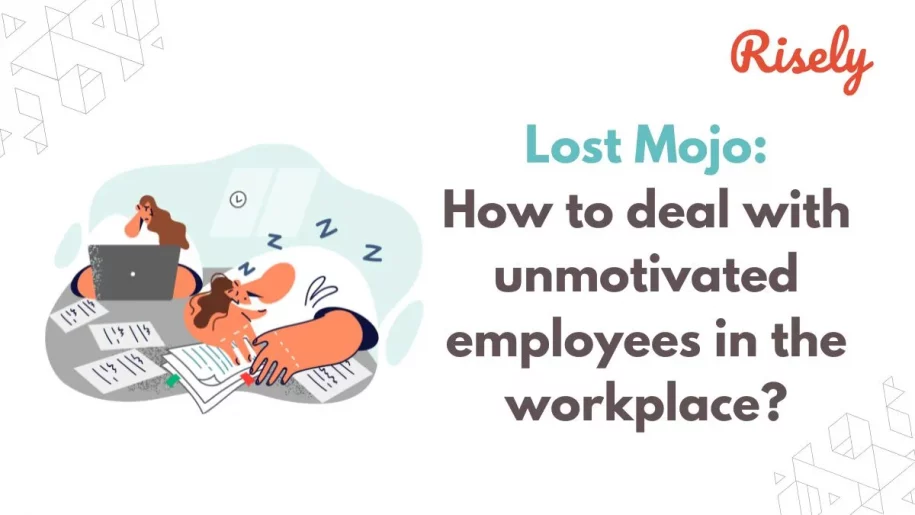Lost Mojo: How to deal with unmotivated employees in the workplace?
Are you struggling with employees who lack drive, energy, and enthusiasm for their work? Do you notice a decline in productivity, creativity, and engagement among your team members? If so, you’re not alone. Many managers and leaders face the challenge of dealing with unmotivated employees, which can be puzzling and frustrating. Motivation is critical in driving employee performance and productivity in today’s work environment. When employees are motivated, they are more likely to be engaged, proactive, and committed to their work. On the other hand, unmotivated employees can have a negative impact on team dynamics, organizational performance, and overall morale. But what causes employees to become unmotivated? Is it a lack of intrinsic motivation, external factors, or a combination? How can managers and leaders effectively address and overcome this challenge? In this blog, we will delve into the world of unmotivated employees, unravel the mystery behind their lack of motivation, and explore practical solutions to rekindle their passion for work.Why do Employees get Unmotivated?
Employees can become unmotivated for a variety of reasons. Some common causes include- Lack of clear goals and expectations: When employees are unclear about their roles, responsibilities, and what is expected of them, it can lead to confusion and demotivation. Without a clear sense of purpose or direction, employees may struggle to find meaning in their work.
- Insufficient recognition and reward: Employees who feel their efforts and contributions are not acknowledged or rewarded may lose motivation. Recognition and reward are important forms of validation that help employees feel appreciated and motivated to continue performing well.
- Limited growth and development opportunities: Employees who feel stuck in their roles without opportunities for growth and development may become demotivated. Lack of advancement opportunities or insufficient support for learning and skill development can lead to boredom and stagnation.
- Poor leadership and management: Ineffective or unsupportive leadership can negatively impact employee motivation. Poor communication, lack of feedback, inconsistent or unfair treatment, and toxic work culture can all contribute to employee demotivation.
- High workload and stress: When employees are overloaded with work or constantly under stress, it can result in burnout and demotivation. A heavy workload, unrealistic expectations, and excessive pressure without adequate support can erode employee motivation and engagement.
- Personal issues and challenges: Employees may face health problems, financial stress, family concerns, or other personal challenges that can impact their motivation at work. These external factors can affect an employee’s ability to focus and perform at their best.
- Lack of work-life balance: Employees who struggle with maintaining a healthy work-life balance may experience decreased motivation. Long working hours, excessive workload, or a lack of flexibility in work arrangements can disrupt employees’ personal lives, reducing motivation and engagement at work.
- Organizational changes and uncertainty: Changes such as restructuring, downsizing, or mergers and acquisitions can create uncertainty and ambiguity, affecting employee motivation. Employees may feel anxious about their job security or struggle to adapt to new work arrangements, leading to decreased motivation.
What are the Signs of an Unmotivated Employee ?
Some common signs of an unmotivated employee at work include:- Decreased productivity: An employee who was previously performing well but suddenly shows a decline in productivity or output may be experiencing decreased motivation.
- Missed deadlines or poor quality of work: If an employee’s work quality or ability to meet deadlines consistently decreases, it could be a sign of lowered motivation and engagement.
- Lack of enthusiasm or initiative: An unmotivated employee may lack enthusiasm or initiative toward their work. They may seem disinterested, disengaged, or reluctant to take on new challenges or responsibilities.
- Increased absenteeism or tardiness: A decrease in attendance or punctuality may indicate decreased motivation, as the employee may feel they need to be more motivated to come to work regularly or be punctual.
- Negative attitude or low morale: An unmotivated employee may exhibit a negative attitude, low morale, or pessimism towards their work or the organization. They may complain frequently or express dissatisfaction with their job.
- Decreased participation or engagement: An employee who was previously engaged in team activities, discussions, or brainstorming sessions but withdrew or showed reduced participation may be experiencing decreased motivation.
- Lack of initiative or innovation: A drop in creativity or innovation in an employee’s work or problem-solving approach may indicate lowered motivation.
- Social withdrawal or disengagement: An unmotivated employee may become socially withdrawn, disengaged, or less interactive with colleagues and team members.
Other Interesting Reads
Examples of unmotivated employees
- A sales team member consistently arrives late for work or team meetings, showing a lack of punctuality and commitment to their responsibilities.
- An employee who does not take the initiative to contribute new ideas, suggestions, or solutions during team brainstorming sessions shows a lack of enthusiasm to participate in team activities actively.
- A team member who does not complete assigned tasks or projects on time fails to meet deadlines and consistently falls behind schedule, indicating a lack of motivation to prioritize and manage their workload effectively.
- One employee repeatedly ignores feedback or performance improvement suggestions from their manager and is unwilling to make changes or improve their work, suggesting a lack of motivation to enhance their skills or performance.
- A team member who frequently calls in sick takes excessive unplanned leaves or has a pattern of absenteeism, showing a lack of commitment and motivation towards their work and team.

How to Motivate Unmotivated Employees?
Motivating unmotivated employees can be challenging, but the right approach and strategies can help them regain their motivation and productivity. Here are some suggestions:- Understand the root cause: Take the time to have candid conversations with the employees to understand the underlying reasons for their lack of motivation. It could be due to various factors, such as a lack of job satisfaction, unclear expectations, personal issues, or feeling undervalued. Identifying the root cause will help you tailor your approach to address the employee’s needs.
- Set clear expectations: Ensure that employees clearly understand their roles and responsibilities and your expectations for their performance. This includes setting SMART (Specific, Measurable, Achievable, Relevant, and Time-bound) goals aligned with their strengths and interests. Clear expectations provide a sense of purpose and direction, which can help boost motivation.
- Provide regular feedback and recognition: Feedback and recognition are crucial for motivating employees. Regularly provide constructive feedback on their performance, highlighting their strengths and areas for improvement. Also, acknowledge and recognize their achievements and contributions publicly, reinforcing their sense of value and appreciation.
- Foster a positive work environment: Create a positive work culture where employees feel supported, respected, and included. Encourage open communication, provide opportunities for collaboration, and show empathy toward their concerns. A positive work environment can help employees feel motivated and engaged.
- Offer learning and development opportunities: Provide opportunities for employees to develop their skills and advance in their careers. This can include training programs, workshops, mentoring, and job rotations. When employees see a path for growth, it can increase their motivation to perform well and contribute to the organization.
- Use intrinsic motivators: Intrinsic motivators, such as autonomy, purpose, and mastery, can be powerful drivers of motivation. Provide employees with autonomy in their work by allowing them to make decisions and take ownership of their projects. Help them understand how their work contributes to the organization’s larger purpose. Also, provide opportunities for employees to develop and master new skills, which can increase their motivation to excel.
- Recognize and address burnout: Unmotivated employees may be experiencing burnout, which can result from prolonged stress and excessive workload. Recognize and address the signs of burnout, such as reevaluating workloads, providing resources and support, and encouraging work-life balance.
Conclusion
Unmotivated employees can present challenges in the workplace, but understanding the root causes and finding effective solutions can lead to positive outcomes. In this blog, we’ve explored various reasons employees may become unmotivated, such as lack of intrinsic motivation, external factors, poor leadership, and mismatched expectations. We’ve also discussed strategies managers and leaders can implement to address this issue, including setting clear expectations, providing regular feedback and recognition, and involving employees in decision-making processes. Managers can create a conducive environment where employees feel empowered, valued, and motivated to contribute their best efforts by taking a proactive approach to employee motivation and engagement. When encouraged, employees are more likely to be productive, innovative, and committed to achieving individual and team goals. Ultimately, a motivated workforce can drive organizational success and create a positive ripple effect throughout the entire team and organization.Understand the concerns of your team effectively with strong constructive feedback skills.
Get the free constructive feedback toolkit to get started and motivate your entire team.
Frequently asked questions
What causes employees to be unmotivated?
Causes of unmotivated employees:
– Insufficient feedback and communication
– Monotonous or repetitive work
– Poor work-life balance
– Inadequate resources or support
– Insufficient feedback and communication
– Monotonous or repetitive work
– Poor work-life balance
– Inadequate resources or support
What happens when employees are unmotivated?
Effects of unmotivated employees:
– Poor quality of work
– Lower employee engagement and morale
– Missed opportunities for growth and innovation
– Poor quality of work
– Lower employee engagement and morale
– Missed opportunities for growth and innovation
What are the signs of demotivated employees?
Signs of demotivated employees:
– Missed deadlines or incomplete tasks.
– Lack of engagement in team activities or discussions.
– Negative attitude or frequent complaints.
– Resistance to change or lack of interest in new challenges.
– Missed deadlines or incomplete tasks.
– Lack of engagement in team activities or discussions.
– Negative attitude or frequent complaints.
– Resistance to change or lack of interest in new challenges.
How to manage unmotivated employees?
Managing unmotivated employees:
– Identify and address underlying issues
– Communicate and listen
– Provide growth opportunities
– Empower and involve employees
– Identify and address underlying issues
– Communicate and listen
– Provide growth opportunities
– Empower and involve employees
Other Related Blogs
How To Create Purpose At Work For Your Employees?
How To Create Purpose At Work For Your Employees? Why is purpose at work important in the modern workplace? Picture this: You stroll into the office, a spring in your…
Be a Top Lead Sales Manager: 10 Tips and Examples
Be a Top Lead Sales Manager: 10 Tips and Examples Being a Lead Sales Manager is not an easy task. It requires unique skills, including excellent communication, leadership qualities, and…
What are the best employee motivation techniques for managers?
What are the best employee motivation techniques for managers? Motivation is an essential part of any working environment, yet it’s not always easy to get your team going. As a…
All about Employee Motivation in the Workplace: Tips & Tricks for Managers 2023
All about Employee Motivation in the Workplace: Tips & Tricks for Managers 2023 It’s Monday morning, and you dread going to work. The thought of another long day at the…


